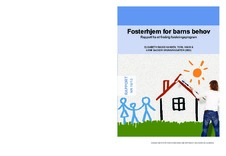| dc.description.abstract | In 2010 a four-year research program about Norwegian foster care practices was initiated: ”Foster care for the needs of children”. The program was commissioned by the Directorate of Children, Young People and the Family. The overall goal of the program was to renew knowledge about Norwegian foster care, in order to aid in the development of a differentiated foster care service which is adapted to the needs of children and young people who are fostered. A foster home is defined as a home receiving one or more children to be fostered, either short-term or long-term. The mainstay of the program has been three projects: (1) Who are the foster children, (2) Becoming and being foster parents, and (3) Educating foster children. New data have mainly been collected from foster parents, caseworkers and their leaders. In addition young adults with foster care backgrounds have contributed. The main goal and the structure of this program made the parents’ perspectives less relevant. New knowledge As a result of the program, existing knowledge about Norwegian foster care has been renewed in several ways: We have updated existing knowledge through a literature review (Backe-Hansen, Egelund & Havik, 2010) and a separate paper about foster home breakdown (Backe-Hansen, Christiansen & Havik, 2013). We have confirmed existing knowledge, thereby increasing trust in the validity of knowledge about Norwegian foster care which has been developed during the last couple of decades. This is particularly pertinent for our results about the processes prospective foster parents go through from the point in time when they decide to foster until the child or young person has become part of the household. We have as well analysed variations and patterns in these processes, amongst other things depending on whether data were collected from kin or non-kin foster carers. We have combined existing and new knowledge. In particular this pertains to knowledge about characteristics of foster children, and questions concerning their participation in their own placements. We have developed new knowledge about Norwegian foster care practice, for instance about how foster children are assessed at the time of placement, what specialized foster care means in a Norwegian context, and determining factors for the duration of emergency foster home placements. In addition we have implemented a Swedish project aimed at increasing foster children’s school achievement, for the first time in Norway. About the project The program combined systematic literature studies with analyses of administrative data about child welfare clients and services, collected questionnaire data from 324 foster parents, 314 caseworkers and 188 child welfare administrators, as well as interviews with 24 young adults with foster care experiences. Thus the main part of the data come from questionnaires, with the advantages and limitations usually associated with this. In addition we have implemented and refined a development project where the 39 participating children were tested before and after the intervention, and where the process of the project has been evaluated over time through questionnaires to foster parents, teachers, and other central actors. Our methodological approaches are presented and discussed in more detail in the second chapter. The report is written in Norwegian. Download the report to read the full summary in English at the back. | en |
| dc.description.abstract | Rapporten er sluttproduktet fra det fireårige forskningsprogrammet Fosterhjem for barns behov. Programmet er initiert og finansiert av Barne-, ungdoms- og familiedirektoratet, med tilleggsfinansiering fra flere andre kilder. Programmet har blitt gjennomført som et samarbeid mellom NOVA, Fafo og RKBU Vest. Fosterhjem for barns behovhar fornyet kunnskapen om norsk fosterhjemsarbeid gjennom tre delprosjekter: «Hvem er fosterbarna?», «Å bli og være fosterforeldre» og «Sammen for læring». Videre forskning foreslås i form av utviklings- og inter-vensjonsprosjekter, også som randomiserte og kontrollerte studier. De siste par tre tiårene har det skjedd så store endringer i norsk fosterhjemsomsorg at man kan snakke om et fosterhjemsløft. Dette må videreføres på en systematisk måte.90,- Rapporter koster kr. 290,- | no_NB |
